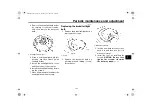
Perio
d
ic maintenance an
d
a
d
justment
7-30
7
b
urns. Avoi
d
any contact with
skin, eyes or clothin
g
an
d
al-
ways shiel
d
your eyes when
workin
g
near
b
atteries. In case
of contact, a
d
minister the fol-
lowin
g
FIRST AID.
• EXTERNAL: Flush with plenty
of water.
• INTERNAL: Drink lar
g
e quan-
tities of water or milk an
d
im-
me
d
iately call a physician.
• EYES: Flush with water for 15
minutes an
d
seek prompt
me
d
ical attention.
Batteries pro
d
uce explosive hy-
d
ro
g
en
g
as. Therefore, keep
sparks, flames, ci
g
arettes, etc.,
away from the
b
attery an
d
pro-
vi
d
e sufficient ventilation when
char
g
in
g
it in an enclose
d
space.
Take care not to spill electrolyte
on the
d
rive chain, as this may
weaken it, shorten chain life an
d
possi
b
ly result in an acci
d
ent.
KEEP THIS AND ALL BATTER-
IES OUT OF THE REACH OF
CHILDREN.
To check the electrolyte level
1. Place the vehicle on a level surfa-
ce and hold it in an upright posi-
tion.
TIP
Make sure that the vehicle is posi-
tioned straight up when checking the
electrolyte level.
2. Check the electrolyte level in the
battery.
TIP
The electrolyte should be between the
minimum and maximum level marks.
3. If the electrolyte is at or below the
minimum level mark, add distilled
water to raise it to the maximum
level mark.
NOTICE:
Use only
d
istille
d
water, as tap water
contains minerals that are
harmful to the
b
attery.
[ECA10612]
4. Check and, if necessary, tighten
the battery lead connections and
correct the breather hose routing.
To store the
b
attery
1. If the vehicle will not be used for
more than one month, remove the
battery, fully charge it, and then
place it in a cool, dry place.
NOTICE:
When removin
g
the
1. Maximum level mark
2. Minimum level mark
1. Battery
2. Battery breather hose
1
2
U1BE26E0.book Page 30 Thursday, June 25, 2015 9:38 AM
















































